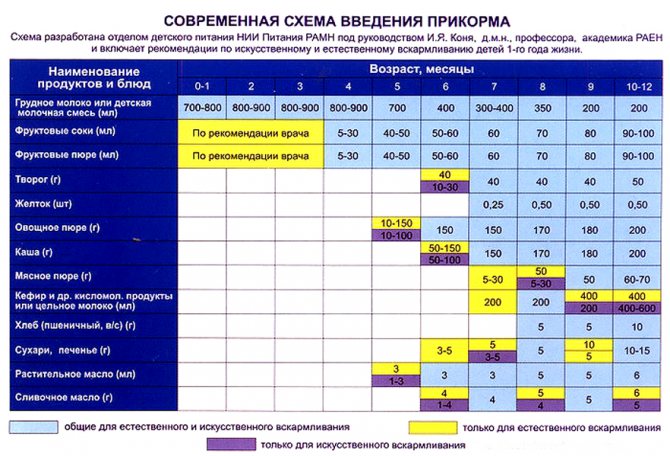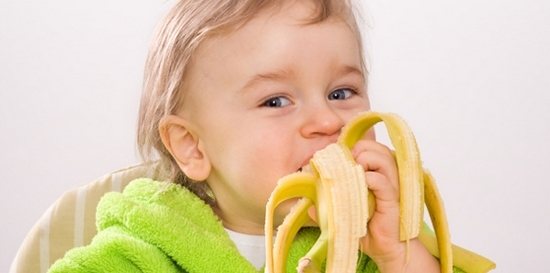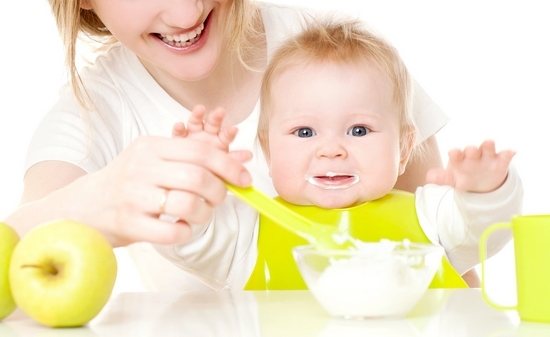When to start feeding your baby
Children in the first months of life receive mother's milk as their only source of nutrition.
Together with it, the baby’s body takes in a set of microelements and vitamins necessary for full physical and mental development. In most cases, with natural feeding, only at 6 months does the baby begin to need a portion of complementary foods. Good health, an increase in body weight, the presence of healthy reflexes and physical indicators indicate that the baby’s development is in full accordance with his age. Modern mothers, for various reasons, replace breast milk with artificial nutrition, depriving the child of natural immune protection. A deficiency of the vitamin complex can lead to the development of pathologies at an early age. It is for this reason that such children are recommended to introduce complementary foods from 4 months of age. Additional nutrition also contributes to the development and normal functioning of the digestive tract.
How much additional nutrition should small children eat, what foods are introduced first, the dosage of complementary foods and how the child should poop at this time are questions that should be answered by the local pediatrician, and not by random people, even those with several children. A new product in a baby’s diet can cause an allergic reaction, which will slow down the process of complementary feeding, making it poor and monotonous.
During a routine examination, analyzing the baby’s development indicators, the doctor gives the mother recommendations on introducing the first individual complementary food and information about how much the baby should eat at one feeding. The basis for such a conclusion may be:
- doubling body weight;
- the child requires frequent feeding;
- interested in the adult menu;
- the child is seated from a lying position;
- pureed food is not reflexively pushed out of the mouth.
Introduction rules
During the first months of life, the child’s body continues to develop and by about 4-6 months his digestive system becomes more advanced, it begins to produce enzymes that can cope with the processing of more “adult” food. Around this age, you should plan to introduce the first complementary foods. There are also other criteria that indicate that the baby is almost completely ready to take his first, denser meals, these include:
- An increase in the child’s body weight by more than twice as compared to his weight at birth;
- Increased feeding frequency. This may indicate that the baby does not have enough mother’s milk and complementary feeding at this time will allow him to adhere to his usual diet;
- The child’s ability to swallow food appears;
- Interest in adult food;
- The child's ability to sit. In order for the baby not to choke, it is important that his head is in a normal vertical position.
Several years ago, all pediatricians advised starting the introduction of fresh juices, starting at almost one month. Now it is not recommended to give juices before three months. The later introduction of juices is due to fewer allergic reactions and intestinal disorders. The optimal time for introducing the first complementary foods is considered to be between 4.5 and 6 months. An earlier start to eating adult food will lead to allergies or intestinal disorders, and a later start will increase the adaptation time.
Sometimes pediatricians prescribe the introduction of the first complementary foods earlier than 4 months, but these must be for very specific reasons. These reasons include:
- Underweight of the baby, which cannot be corrected with the help of formulas;
- Anemia in a child.
What rules should be followed during complementary feeding?
In order to eliminate the likelihood of developing food allergies, diarrhea, constipation, and intestinal colic, young mothers should remember that haste and inattention in complementary feeding are simply unacceptable. For the first time, the baby should eat ¼ teaspoon of an unfamiliar product. The new dish is introduced within 2 weeks and is given in full, provided that none of the following symptoms threaten the baby. How many mistakes can be avoided by knowing in advance the main principles of introducing complementary foods.
- Health saving. Give new food provided that the child is completely healthy. It is forbidden to start complementary feeding after vaccinations, at the time of adaptation to a new climate, in unfamiliar conditions, in hot weather. The baby should eat a new dish in the first half of the day, during the rest of the time the mother monitors his reaction, behavior, and how he goes to poop . If deviations from the child’s usual state occur, stop feeding and consult a doctor.
- The baby should start eating a new dish at the beginning of feeding. Then comes his usual breast milk or formula.
- The baby should eat complementary foods from a teaspoon, and not suck from a bottle. This develops the child’s chewing muscles and promotes better teething.
How to introduce complementary foods correctly?
Basic rules for introducing complementary foods:
- A new complementary food product cannot be introduced: if the child is sick;
- if the child has an active phase of teething;
- on the day of preventive vaccinations;
What to feed a baby up to one year old
Before you get acquainted with the age intervals of complementary feeding, you should remember that each dish is introduced separately. There are as many types of products as there are adaptation periods.
4 months
Fruit juice, puree. Fruits should be, first of all, from the region where the baby lives: pears, apples. But the very first one should be an apple, which does not cause food allergies and is rich in vitamins. You can prepare complementary foods yourself or buy them in small portions in the baby food department.
5 months
Vegetables are introduced one by one: zucchini, cauliflower, broccoli, pumpkin, potatoes. If they are well absorbed, you can cook stew.
6 months
Porridge is added. We give preference to a hypoallergenic industrial product based on rice, corn, and buckwheat. Porridges are diluted with water or milk formula, which the child is currently consuming, so that the baby can poop safely. The volume of complementary foods starts from 1 tsp and increases to 100 g. How long does it take to fully introduce cereals into a baby’s diet? You need to increase the weight of complementary foods based on the child’s well-being and his desire to eat the entire dish. It is worth considering that complementary feeding products cannot be mixed!
7 months
After the porridge, the meat product is introduced, rubbing it to the consistency of puree. Preference is given to turkey and rabbit meat. The variety should be low-fat and hypoallergenic.
8 months
During this period, it is allowed to introduce fermented milk products: kefir, cottage cheese, and certain types of cookies. A prerequisite is good tolerance to cow's milk. If symptoms of food allergies are observed, the child does not want to poop , then complementary feeding will have to be suspended for a couple of months.
9 months
You should know that complementary fish foods can cause an allergic rash, so you should be very careful when introducing them into your diet. Preference is given to pike perch, pike or other types of low-fat fish. There is no need to rush into this type of complementary feeding; it is better to wait a little more time for the child to fully adapt to new products.
10 months
The baby is offered yolk and broth.
How long should it take after introducing a new product? If the baby is feeling well, there are no whims, or refusals to eat, new complementary foods are introduced immediately after the previous one has been digested.
It is worth considering that fried, smoked, and pickled foods are contraindicated for children. By the end of the year, the baby's main diet should be solid food, with milk and formula serving as drink.

Baby feeding table by month up to one year
At what age can you give your child a banana?

Banana has a sweet, pleasant taste and a rather soft structure. Due to the presence of fiber in its composition, doctors advise consuming banana regularly for better cell formation.
The fruit contains a large amount of calories, but you should not forget that this fruit is an allergen and may not be suitable specifically for your child. You should not give a banana to a child of 5 months, since his intestines are not fully formed and the baby simply will not be able to digest this product, which will lead to an upset stomach. It is better to introduce banana complementary foods after six months. Doctors believe that this is the optimal age for infants and artificial babies.
You need to start complementary feeding from 5 months with vegetables and fruits that grow in your climate zone, and only in small portions. It is better to use the following vegetables and fruits for first complementary foods:
- carrot;
- cabbage;
- apples;
- pears.

For children with weak intestines, banana should not be given until 8-9 months, as this can lead to disruption of the internal microflora. Bananas are introduced into the diet in small portions, no more than one teaspoon. It is necessary to monitor your baby's stool, as overfeeding can cause a number of problems:
- colic;
- bloating;
- loose stool.
How to introduce new foods to your baby
Parents are required to know not only how many times to feed the baby, the volume of meals and the requirements for complementary feeding of the baby. They should also have an idea of how to properly present a new dish to their child. Let's look at a few tips for creating a comfortable environment during the introduction of additional nutrition.
- Table setting. During feeding, you should sit with your child at a beautifully decorated table. We teach him from early childhood to aesthetics and food culture.
- Availability of bright, beautiful dishes. It will attract the baby's attention to what is in it.
- Calm and friendly tone of parents. Affectionate communication makes the child want to try a new dish.
- Artistic word. The ability of parents to use jokes, sayings, and poems when communicating with their child attracts the child’s attention and encourages him to eat food in a playful way.
- Lack of toys on the table. Nothing should distract the child's attention from the eating process.
- New introductions should be carried out without unnecessary fuss, assertiveness, nervousness, or the desire to feed the baby at all costs. If the child categorically refuses to eat everything, stop and offer him an already familiar dish.
What complementary foods should I give my baby at 4 months?
Those mothers for whom the main table for introducing complementary foods is not a direct recommendation are often interested in how to introduce complementary foods at 4 months correctly.
Basically, complementary feeding begins at 4 months with artificial feeding .
The first “experience” is the yolk of a chicken egg , how to give it is described above. To properly feed your baby further, you can gradually introduce the following product.
cottage cheese into your diet , starting with half a teaspoon. But still, ideally, a complementary feeding regimen at this age should be approved by a specialist. Therefore, you should talk to your local pediatrician about what complementary foods you can give from 4 months of age while breastfeeding. It is necessary to take into account individual recommendations on how to properly start complementary feeding at this age, since the state of the digestive tract and the health of the baby as a whole depends on this in the following months, when you expand his diet, introducing porridge, potatoes and other products.
Why was there no 10,000 child benefit in August?
“Currently, there is no official decision regarding the payment of a one-time benefit for children for the third time. Now you can receive only two payments of 10,000 per child from 3 to 16 years old. We receive hundreds of calls on this issue every day, but we don’t decide anything, we just follow the orders of the authorities. As soon as they sign the decree, we will immediately pay what is due. But for this you need an appropriate document,” explained the Pension Fund hotline.
But in September 2020, those parents who have not previously applied for a payment of 10,000 rubles will be able to receive a payment immediately for June and July. But at the same time, all parents who are on the labor exchange and receive unemployment benefits are paid an additional 3,000 rubles in August and September. for each minor child.
Let us remind you that in September 2020, this support measure can be received by everyone who is on the labor exchange, regardless of the amount of the assigned benefit, even if they have not worked before or were not officially employed. 3000 rubles each. will be paid for each child in the family.
There is a debate on social networks about whether the payment of 10 thousand rubles will be extended until September. Some refer to the words of the head of the Cabinet of Ministers, Mikhail Mishustin, about the extension of social support measures taken in connection with the coronavirus until mid-September.
How to introduce complementary foods at 7 months?
The age of seven months is the period when porridge should appear on the baby’s menu. The mother can ask the pediatrician which cereals can be introduced first. But it is important that gluten-free and dairy-free cereals are gradually introduced to a 7-month-old child.
Goat and cow milk, as well as milk porridges, are introduced after the child reaches one year. Doctors, advising what a child should eat, claim that the baby should not eat milk porridge , as they negatively affect the gastrointestinal mucosa and increase the risk of diseases of the digestive system.
If it is difficult to introduce porridge into the diet because the child refuses to eat porridge without milk, you can add breast milk or formula to the porridge. Since gluten is harmful for a child under one year old, since it provokes celiac disease (pathology of the large intestine), the nutrition table for a 7-month-old child suggests that he can be given gluten-free porridge - rice, buckwheat, corn.
When creating a menu for breastfeeding or creating a formula-fed baby's diet at 7 months, you should take into account that you can prepare porridge yourself or add ready-made porridge to the menu, which can be purchased at a specialized store. Making this porridge is very simple - you just need to add a little water. Your doctor will tell you what you can give your baby to eat at 7 months. But no matter what food the mother introduces, it is necessary to clearly monitor how the seven-month-old baby’s body perceives it: whether allergies are manifested, whether the baby’s growth and development are normal. If the product is poorly absorbed, the stool may change and an allergy may appear. It should be taken into account that allergic manifestations can appear not only during the first time after the introduction of a new product, but also after its volume has been significantly increased. Therefore, a new product should be introduced gradually, observing how the child behaves for a week or two.
How to introduce complementary foods at 6 months?
If a mother begins to introduce complementary foods to her child at 6 months while breastfeeding, as suggested by the modern table for introducing complementary foods and the advice of pediatricians, it is important to gradually introduce each new product to the menu.
vegetables are the first to be introduced into the diet of children at six months . porridge to children who have a very low weight for their age . You can ask your doctor what cereals can be given to such a baby. This is mainly rice and buckwheat porridge .
The complementary feeding scheme from 6 months onwards is as follows: initially, the baby needs to introduce vegetable puree , it is best to do this at lunchtime. What can a child who is starting to be fed with vegetables eat? Experts recommend initially giving your baby zucchini, followed by broccoli, cauliflower, carrots, and pumpkin. Vegetables are the food from which children are least likely to develop allergies. However, the menu for a bottle-fed baby suggests that a 6-month-old baby eats vegetables such as pumpkin and carrots no more than 2-3 times a week.
At 6 months They begin to give such puree with a small dose - initially the baby should eat 1 teaspoon of the dish, then the dose should be gradually increased.
If bottle-fed feeding was initially practiced, and the child’s development, in the opinion of the pediatrician, does not deviate from the norm, already during this period you can gradually begin to mix vegetable purees. However, such a vegetable mix can be given to the baby only after he has tried puree from one type of vegetable, and he does not have an allergic reaction .
A new type of food is given to the baby only on an empty stomach, so that one can clearly determine how the baby reacts to such food. For example, if a mother is just starting to give yolk to her child, you need to wait with vegetables.
In many ways, where to start the first complementary feeding at this age depends on the preferences of the parents. So, mom can prepare puree from broccoli and other vegetables on her own. Having decided which vegetables to start with, you need to take the vegetables, rinse them well under running water and remove seeds and peels. Next, they are cut and placed in a double boiler or pan. Cooked vegetables (it is better to steam them to puree) are chopped with a blender, after adding water or vegetable broth. As a result, you need to prepare a puree similar in consistency to kefir. An older baby can be fed with thicker purees, but during this period, as a rule, he already eats porridge and other foods.
Such food should not be stored - the complementary feeding norm stipulates that the baby receives only freshly prepared food. By the way, salt, spices, and sugar are not added to the puree.
The diet of a child at 6 months stipulates that it is too early for the mother to think about the questions of what kind of fish or what meat to start complementary feeding with.
Approximate schedule for introducing vegetable complementary foods
| Days | Scheme |
| First | 5 g of zucchini puree, then supplement with breast milk or formula |
| Second | 10 g of zucchini puree, then supplement with breast milk or formula |
| Third | 20 g of zucchini puree, then supplement with breast milk or formula |
| Fourth | 40 g of zucchini puree, then supplement with breast milk or formula |
| Fifth | 80 g of zucchini puree, then supplement with breast milk or formula |
| Sixth | 120 g of zucchini puree, then supplement with breast milk or formula |
| Seventh | 150 g of zucchini puree, then supplement with breast milk or formula |
| Eighth | 5 g of cauliflower puree, you can add zucchini if you are not allergic to it. |
| Ninth | 10 g of cauliflower puree, after which the scheme is repeated every day, as with zucchini puree |
When you can give your child mashed potatoes depends on what vegetables you have already introduced before this period of his life. As a rule, potatoes are introduced a little later.
If the child does not eat the entire portion, it means that the amount of supplementary feeding is too large for him. The baby refuses, which means there is no need to force him, since eating habits are formed already in the first year of his life.
How much money did the government allocate in September?
In total, over 24 billion rubles have been allocated from the reserve fund of the Russian government. Almost another 22 billion rubles will be allocated to support doctors, paramedics, nurses and ambulance drivers.
More than 321 million rubles will be used to pay employees of the centers of the Federal Medical and Biological Agency. Another more than 1.8 billion rubles will be allocated to payments to employees of nursing homes and boarding schools for the disabled, according to the government website.
Incentive payments are received by social workers who work under special regime conditions: they live on the territory of hospitals during a work shift (14 days). Additional payments, which were initially transferred from April 15 to July 15, were extended until September 15, 2020.
Similar payments are due to social workers, psychologists and teachers (educators, labor instructors, speech therapists, music directors, etc.). Junior medical staff (housekeepers, orderlies, nurses) are paid 15 thousand or 25 thousand rubles, and technical staff - 10 thousand or 15 thousand rubles.
And yet, many parents are waiting for the extension of the 10,000 ruble benefit at least by the beginning of the school year; new payments to children in the fall of 2020 due to the pandemic are still being actively discussed. But official sources have not yet disclosed such information. The latest news about payments will appear on our website as it becomes available.
Should I expect payments in September 2020 for children from 3 to 16 years old?
The media spread the news that State Duma deputies approved the idea of extending the payment of cash benefits for children in the amount of 10,000 rubles by the beginning of the school year. Mikhail Tarasenko, deputy of the State Duma of the Russian Federation, first deputy chairman of the State Duma Committee on Labor, Social Policy and Veterans Affairs, told reporters about this.
He stated that he considers it appropriate for the children’s parents to be paid additional money from the Pension Fund of Russia at the rate of 10 thousand rubles for each child to help get their children ready for school. According to the parliamentarian, some restrictive measures continue to be in effect in a number of regions, which aggravate the financial situation of some Russians.
Putin himself should come up with such an initiative in his address to the people. This support measure would be very useful in preparing children for school and in purchasing stationery and school uniforms, which are not cheap.
It also turned out that not all Russian families received payments for June and July, so it is the that did not previously receive benefits that will definitely receive these payments in September 2020.
The Pension Fund of the Russian Federation notes that we are mainly talking about those who live in the northern or mountainous regions. It is often difficult to get to such places; there is not always an Internet connection. For these reasons, about 10% of Russian families have not yet received child benefits.
Now the Pension Fund is compiling lists of such citizens. The department explained that such families will receive money for two months at once. In addition, the government decided to reduce the list of documents required to obtain benefits. Departments will receive a significant part of the necessary information through the electronic interaction system.










